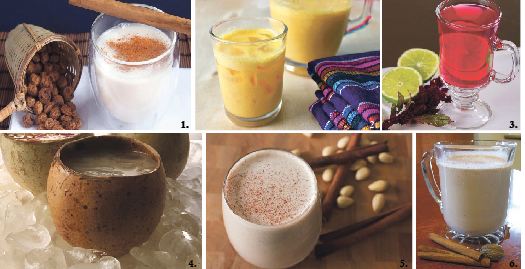Goa is abuzz with excitement as vintage bike and car owners, users, collectors and fans are decking […]

HOW ABOUT PASTEIS DE NATA AND ORCHATA IN YOUR COFFEE?
June 27- July 03 2020, Life & Living June 26, 2020- Horchata de Chufa: Widespread throughout Spain, horchata de chufa is made from ground and sweetened tiger nuts. Tiger nuts, a superfood, are used as a milk substitute for the lactose-intolerant. In Spain, horchata de chufa is served cold with a side of fartons, a sweet donut-like pastry. 2. Horchata de Melón: As evident by the name, horchata de melón is made out of ground melon seeds. 3. Ecuadorian Horchata: Horchata in Ecuador is completely different from what one would expect to see. Ecuadorian horchata is infused with 18 different herbs that result in the drink possessing a clear red color. 4. Horchata de Morro: This is Salvadorean take on the classic drink. It uses gourd seeds as an alternate ingredient. 5. Semilla de Jicaro: This version of horchata is popular in Central America, specifically in Costa Rica, Honduras, El Salvadore, and Nicaragua. Semilla de jicaro consists of jicaro seeds ground with rice and a variety of ingredients ranging from cinnamon and cocoa, to vanilla, sesame seeds, and nutmeg. Nuts like almonds, peanuts, cashews and tiger nuts may also be included. 6. Horchata de Ajonjolí: Also called sesame horchata, horchata de ajonjolí is made with – you guessed it – ground sesame seeds! In Puerto Rico, this variation is made by boiling cinnamon sticks, vanilla, and sugar in water then pouring it over ground sesame seeds to sit overnight. After being strained, the mixture can be used in multiple ways depending on what the recipe calls for. Some call for lime zest, coconut milk, or even rum.
By Tara Narayan
IT’S been an utterly depressive week of searching for a ray of sunshine! Novel coronavirus making inroads into Goa, the gory death of 20 Indians soldiers in Ladakh, and me in search of food to drown my depression in. As usual tired of cooking at home, I suddenly decided to go on a spree of looking for food outside and ended up at savoring various agreeable things like vegetable pulao at Café Tato, I savored it with their most agreeable pale green coconut chutney, usually served with samosa or batatvada — I had to pay extra for it because I asked for it with my veggie pulao!
Life is like that only. It’s a chutney I could buy to take home. I don’t know why nobody markets fresh chutneys green, creamy ivory, tangerine orange, tomato red, royal velvety purple or magenta….I would buy them daily if they are reasonably priced. Just as I would buy an honest sabzi, dal, stew, etc, if it is reasonably priced. What is reasonable? More like 50 and not100 per 250g!
Anyway, I was at a loose end one recent afternoon and was tempted to drop into the vintage premises of Mr Baker 1922 while down town Panaji to check if there was any semolina cake (baath), but there were none that day. Looking out of the glass panes I was tempted by the sight of a scarlet red gulmohur still breaking into bloom outside at the Jardin de Garcia, and decided to sit a bit.
Mr Baker’s a pleasant place to sit a bit and it has some tempting things on the menu. The menu for the day chalked up Orchata and I asked Nenette Fernandez here if I could taste a spoonful of it in the black sugarless coffee I’d ordered? Happily she obliged and I discovered this Portuguese-styled almond syrup really made my cup of coffee come alive with a wonderful discreet flavor!
It didn’t make my coffee sugary. Hey, I’d rather drink a good cup of black coffee flavored with orchata, than orchata all by itself in a sherbet which can be cloyingly sweet, although I must tell you orchata has a lot of fans in Goa. I suppose served on the rocks it would make for a perfect tea-time drink instead of hot tea during the summer months. Although I’ve been reading up about it and there is orchata and “horchata” or “orxata” which is something different out in Mexico, Spain, elsewhere in African countries like Nigeria and Mali where a version is known as “kunnu aya” (my research tells me) and originally made out of these soaked, ground and sweetened tiger nuts…they reached far away places such as Valencia in Spain where the famous horchata de chufa was born. A memory during a trip to Barcelona in my salad years reminds me that I’d seen these hot steamed tiger nuts with a Ramblas promenade vendor and tasted horchata a la Spanish style; hey, there’s a lot of fascinating history revolving around the origins of horchata and horchata, but don’t confuse it with this Portuguese-styled almonds-based orchata syrup I’m referring to here in Goa at Mr Baker’s.
I confided in Nenette that it would be a great hit if they offered hot orchata-laced coffee on their menu, like the kind I’d just had! I’m not sure she liked the idea because while coffee is priced 20, the orchata sherbet is listed at60. How about coffee with orchata in it at 30? Nope, she said, not economical enough but she would think it over. Okay, think it over my dear and I’ll be there more often for orchata-laced coffee! I dare say this almond sherbet concentrate of orchata is hard to do, requiring painstaking patience. Don’t forget it is made with almond milk and almonds are costly nuts (some may combine them with groundnuts in Goa and add almond essence but don’t be fooled). It’s hard to find real orchata anyway. Nevertheless it’s a good idea to keep a bottle of Orchata at home, for it makes for an unusual and delightful drink. Orchata is refreshing if served right and that is not too heavily sugar laden. This is just to say unexpectedly a tablespoon of orchata in my coffee and suddenly I felt like life was divine, celestial, worth living anew…it takes so little to please and cheer me up! ACTUALLY, it’s been a week of discovering (or re-discovering things Portuguese) and it all started when some feverish posts on Facebook caught my attention. My friend Marlene and some folk were waxing lyrical over the world-famous Portuguese egg custard tarts called pasteis de nata or pasteis de Belem…and there I was looking at pictures of these warm, flaky pastry, creamy egg custard tarts with their burnished gold looks…of course they seduced my eyes and mind a long time ago. Indeed, one may go crazy over these pasteis de nata which many folk in Goa who’re seen life and times in Lisbon feel nostalgic about… hence I suppose all the pasteis de nata talk over Facebook with several folk placing orders for them. Marlene de Noronha Meneses of Miramar Fortune Hotel makes them in a personal capacity but doesn’t put them out at the Fortune patisserie counter. I’m not sure if Jila Bakery out in Loutalim makes them, perhaps on order, I rate their crème eclairs the best in Goa. Then I learned that Recitas da Avo who have shifted to Margao have made a fine art of doing these desirable pasteis de nata, sometimes also called pastel de nata. They also do delivery in Panaji, if you’re interested, look them up. They’re priced at600 per dozen if I remember right, I called up and spoke to Ruben Barros who said they do delivery somewhere near Miramar beach in Panaji.
SO it’s been a week from an agreeable vegetable pulao of Café Tato to orchata-flavored hot coffee at Mr Baker’s and thoughts of ordering pasteis de nata when a birthday comes up next…and my constantly jaded, depressed soul is back in entertainment form. Yes, I would put delectable pasteis de nata next to sweet somethings like bol sans rival (cake without rivals, also of Portuguese name and fame) and French crème eclairs…all seduce eyes and palate and are definitely to live for on a soggy monsoon rainy day Sunday afternoon. Pasteis de nata followed by a cup of strong black coffee with orchata in it….stir, stir, stir up some magical rainbow-touched clouds if you can and rejoice for no reason at all except an enchanted moment here today, gone tomorrow!
HERE’s a recipe for orchata which I rather like. It’s described as an Indian almond and rose water drink though and considered one of Goa heat-beating cold drinks for children! Writes Maria Teresa Nenezes’ in her Goan cookbook and memoir “The Essential Goa Cookbook,” the drink was offered at her sister’s wedding party in 1935, when “Trays of wine, liquors, the special xaropes, or syrups, of Goa…We children concentrated on orchata, and of course, sampled every tray that passed us!”’
Orchata
(Yields or makes four and quarter cups,
time taken 40 minutes)
Ingredients: Ice; 2 cups or 12 oz raw almonds; one-third cup sugar; half tsp rose water.
Instructions on how to make: Set a large bowl of ice water by the sink. Bring a medium pot of water to rapid boil. Stir in the almonds and let them cook for ten to 15 seconds. Drain and plunge into ice water to cool and loosen skins, rub skins off between hands and discard almond skins. Transfer almonds to a blender and blend with one and half cups of ice water at high speed till you get a smooth consistency. Line a fine mesh stringer with double cheesecloth and strain our almond milk as much as possible. Repeat process with any remaining almond pulp, thrice if you wish. Refrigerate almond milk and make rose syrup.
To make rose syrup bring two thirds cups of water with the sugar to a boil, simmering till you get a reduced syrup. Remove from heat and stir in the rose water. Transfer to a heat-resistant bowl and refrigerate. At time of serving you may pour out almond milk, sweeten with rose syrup to taste, serve over ice if desirable. Enjoy.
Note: You may also of course make a sweet almonds concentrate or orchata concentrate for more practical use, but that’s another recipe done differently.















